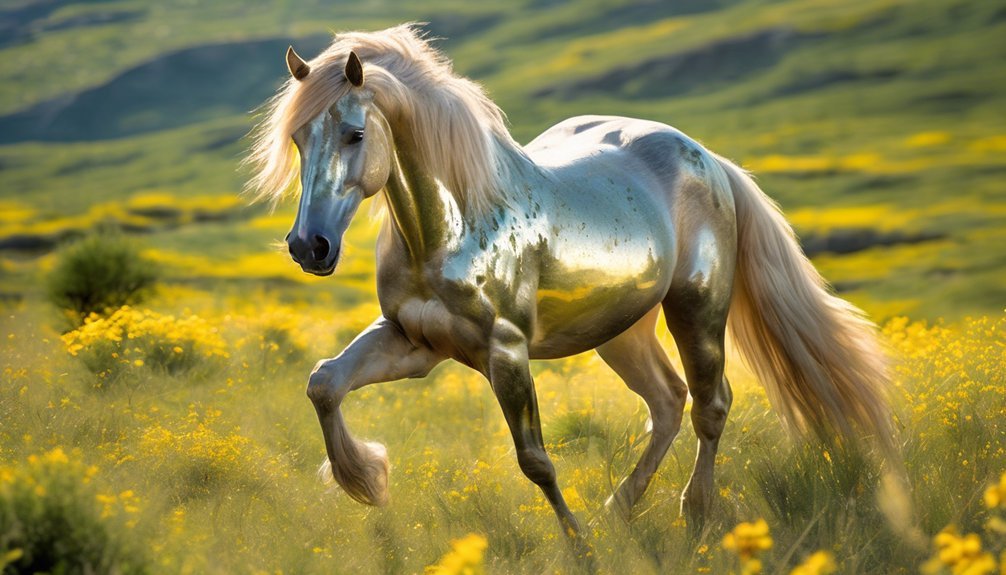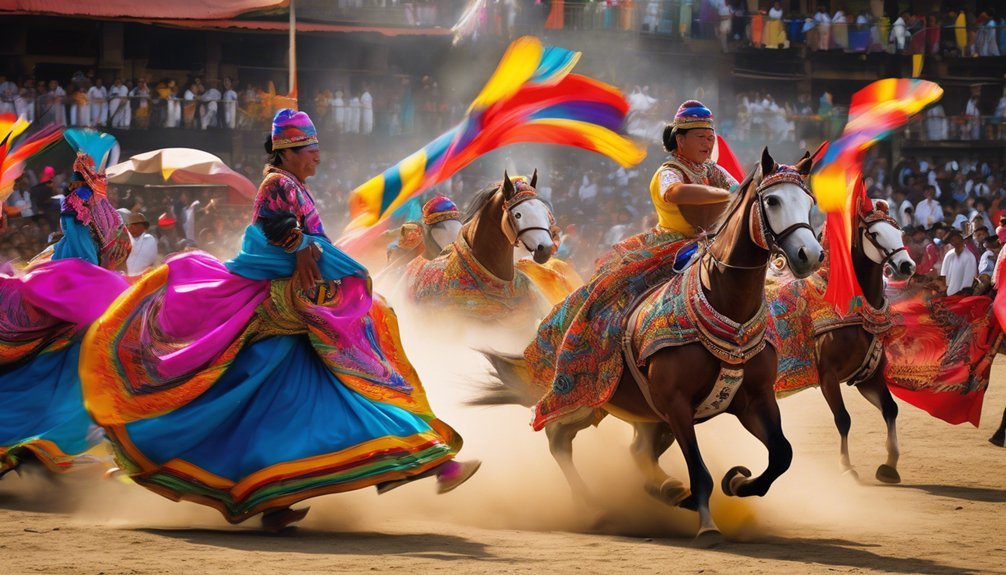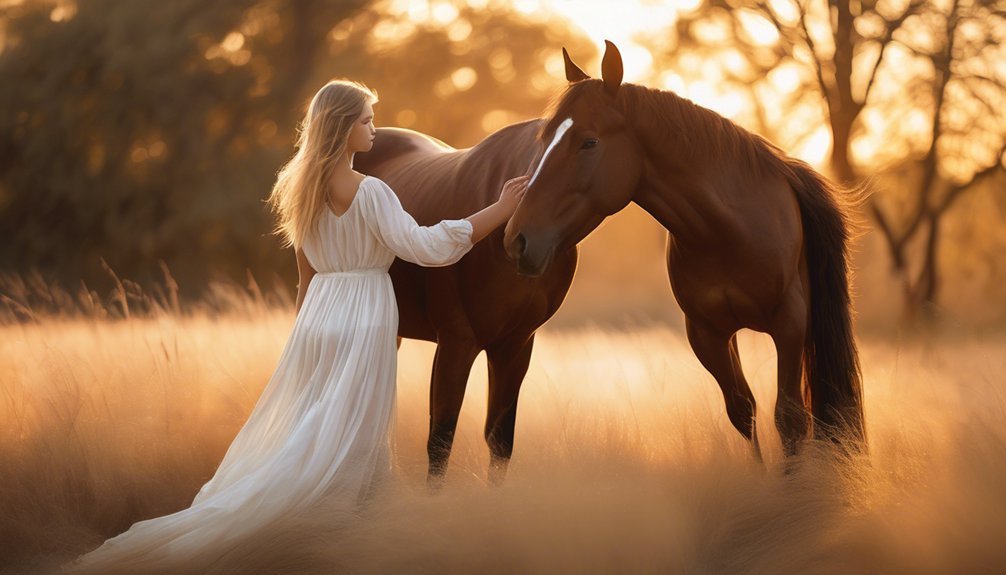
Your bond with your horse goes beyond mere riding; it's a partnership founded on trust and understanding. Every grooming session, every training exercise, and even the quiet moments spent together deepen this connection. As you communicate, both verbally and through subtle cues, you learn to navigate each other's emotions and intentions. But what happens when challenges arise? The journey of building that bond can take unexpected turns, revealing layers of resilience and collaboration.
Key Takeaways
- Trust is fundamental in the horse-rider relationship, developed through bonding activities and consistent time spent together.
- Effective communication through non-verbal cues and clear body language enhances understanding and connection.
- Positive reinforcement and clear cues build responsiveness, fostering a stronger partnership between horse and rider.
- Overcoming challenges together deepens emotional connections and transforms obstacles into opportunities for growth.
- Shared experiences, such as trail rides and competitions, strengthen the bond and celebrate achievements as a team.
The Foundations of Trust in the Horse-Rider Relationship

When you first approach a horse, building trust becomes essential for a successful partnership. Start by engaging in bonding activities that foster a sense of safety and connection.
Simple actions like grooming and offering treats can create a warm atmosphere, allowing your horse to feel comfortable around you. Incorporate trust exercises, such as leading the horse in a circle or gently asking them to move forward, to reinforce your bond.
Remember, patience is key; each moment spent together strengthens that invisible thread of trust. As you nurture this relationship, your horse will begin to see you as a partner, not just a rider.
Embrace the journey, and you'll discover a deep, rewarding connection that enhances both your experiences together.
Communication: The Key to Understanding Each Other
Effective communication with your horse goes beyond words; it's about the subtle signals you both send.
By recognizing non-verbal cues and establishing mutual trust, you can create a deeper bond that enhances your riding experience.
Consistent training practices further reinforce this connection, allowing you to understand each other more intuitively.
Non-Verbal Cues
Understanding non-verbal cues is essential for building a strong bond between you and your horse. This silent communication relies heavily on body language, which plays a crucial role in how your horse perceives you. By tuning into these cues, you foster a deeper connection.
Here are some key aspects to observe:
- Ear Position: Forward ears indicate curiosity, while pinned ears signal discomfort or annoyance.
- Tail Movement: A swishing tail can indicate irritation, whereas a relaxed tail shows calmness.
- Facial Expressions: Pay attention to your horse's eyes; wide eyes may indicate fear, while soft eyes suggest relaxation.
- Body Posture: A horse standing squarely shows confidence, while a horse shifting weight may be anxious.
Mutual Trust Building
Building mutual trust between you and your horse hinges on clear communication. Start by engaging in trust exercises that help you both understand each other's body language and emotions.
Simple activities, like leading your horse over poles or backing up together, foster confidence. These bonding activities create a shared experience, deepening your connection.
Always be patient and observant; your horse's reactions provide valuable insights into their feelings. Regularly spend time just being together, whether grooming or quietly standing side by side.
This quiet interaction builds a foundation of trust, allowing your horse to feel safe and secure in your presence. Remember, trust isn't built overnight—it grows through consistent, loving communication and shared experiences.
Consistent Training Practices
While consistent training practices are crucial for developing a strong bond with your horse, effective communication lies at the heart of this relationship.
When you prioritize understanding your horse, it deepens your connection.
Here are four key elements to enhance your training routine:
- Establish Consistent Routines: Keep your training sessions predictable to build security.
- Use Clear Cues: Communicate effectively through body language and vocal commands.
- Implement Training Rewards: Reinforce positive behavior with treats or praise to motivate your horse.
- Observe and Adapt: Pay attention to your horse's reactions and adjust your approach accordingly.
Building a Strong Partnership Through Training
To build a strong partnership with your horse, effective communication techniques are essential.
By honing your cues and signals, you foster mutual trust, creating a bond that enhances both your riding experience and your horse's performance.
Together, you'll navigate challenges and celebrate successes, solidifying your connection with every training session.
Effective Communication Techniques
How can effective communication transform your relationship with your horse? By mastering verbal communication and body language, you can create a deeper bond that fosters trust and understanding.
Here are four techniques to enhance your connection:
- Be Consistent: Use the same cues and commands to help your horse understand what you want.
- Observe Body Language: Pay attention to your horse's posture and movements; they can reveal much about their feelings.
- Use a Calm Voice: Your tone can soothe or excite; choose words that promote relaxation and focus.
- Practice Patience: Allow your horse time to respond; rushing can lead to confusion and stress.
These techniques will help you build a partnership rooted in mutual respect and empathy.
Mutual Trust Development
Effective communication is just the starting point for building a strong partnership with your horse; mutual trust takes that bond to the next level. Engaging in trust exercises is essential for fostering this connection.
Start with simple activities, like leading your horse through obstacles or allowing them to explore new environments. These moments build confidence and deepen your emotional bonding. Pay attention to your horse's reactions and be patient; each interaction solidifies their trust in you.
As you progress, incorporate groundwork and riding exercises that challenge both of you. Celebrate small victories together, reinforcing that trust is a two-way street.
Ultimately, this journey will create a profound relationship where you and your horse thrive together, united in your shared experiences.
The Emotional Connection Between Horse and Rider
The bond between a horse and rider often transcends mere companionship, blossoming into a profound emotional connection that enriches both lives. This emotional attachment can be cultivated through shared experiences, creating memories that last a lifetime.
Here are four ways you can deepen this connection:
- Consistent Time Together – Spend quality time grooming and bonding with your horse.
- Mindful Communication – Learn to read your horse's body language and respond with empathy.
- Shared Adventures – Explore new trails or participate in competitions together for unforgettable bonding experiences.
- Positive Reinforcement – Celebrate accomplishments and milestones, reinforcing trust and love.
These nurturing moments not only strengthen your relationship but also create a unique, heartfelt connection that defines your journey together.
Overcoming Challenges in the Relationship
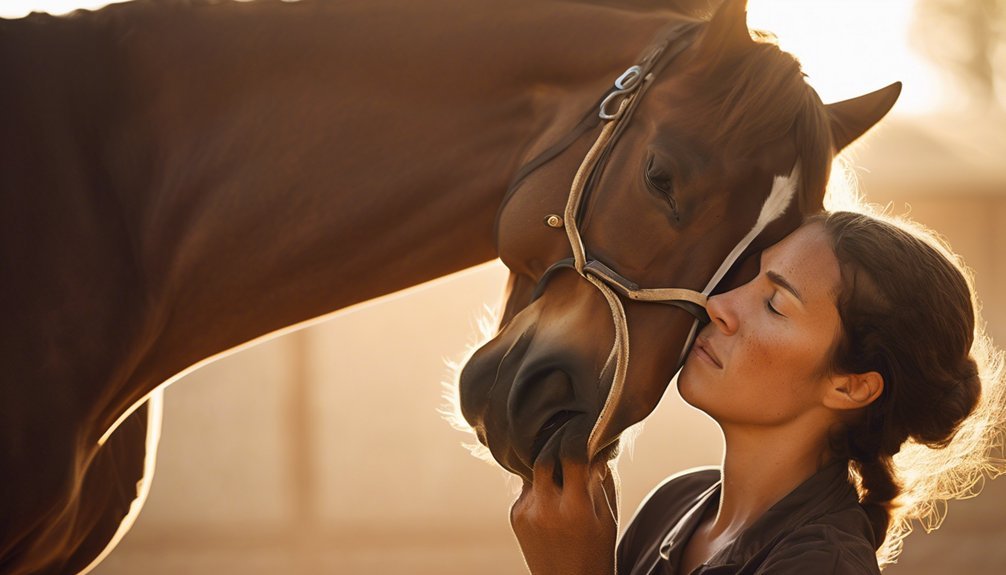
Even the strongest bonds between horses and riders face challenges that can test their relationship. You may find yourself grappling with fear during a ride, an emotion that can create distance between you and your horse. Recognizing this fear is the first step toward overcoming it. Embrace the discomfort, and take small steps to build confidence, both for yourself and your horse.
When handling setbacks, remember that they're part of the journey. Communication is key; your horse can sense your emotions. By remaining calm and patient, you can foster trust and connection.
Celebrate the small victories together, reinforcing your bond. Ultimately, navigating these challenges deepens your relationship, transforming obstacles into opportunities for growth and understanding.
The Impact of Riding Styles on Bonding
While various riding styles can shape your experience with a horse, they also play a crucial role in strengthening your bond. Your riding preferences, whether they lean toward Western techniques or English disciplines, significantly affect your connection.
Here are four key impacts:
- Emotional Impact: Different styles evoke varying feelings, enhancing your mutual understanding.
- Rider Confidence: Mastery of style variations boosts your confidence, encouraging a more assertive partnership.
- Horse Responsiveness: Consistent practice in your chosen discipline fosters better communication and trust.
- Performance Outcomes: Achieving goals together solidifies your relationship, showcasing teamwork and commitment.
Ultimately, the way you ride not only influences your skills but also deepens the emotional ties between you and your horse.
The Role of Care and Attention in Strengthening Ties
Caring for your horse goes beyond the basics of feeding and grooming; it's a vital component that deepens the connection you share. Engaging in bonding rituals, like gentle brushing or quiet moments together, fosters trust and affection.
These daily routines become special time when you both unwind and connect on a deeper level. As you spend time observing your horse's unique behaviors and quirks, you'll build an understanding that strengthens your bond.
Your attentiveness not only nurtures their physical well-being but also nurtures their emotional health. By investing time and care into your relationship, you create a partnership rooted in love and respect.
The Joy of Shared Experiences in Equestrian Life
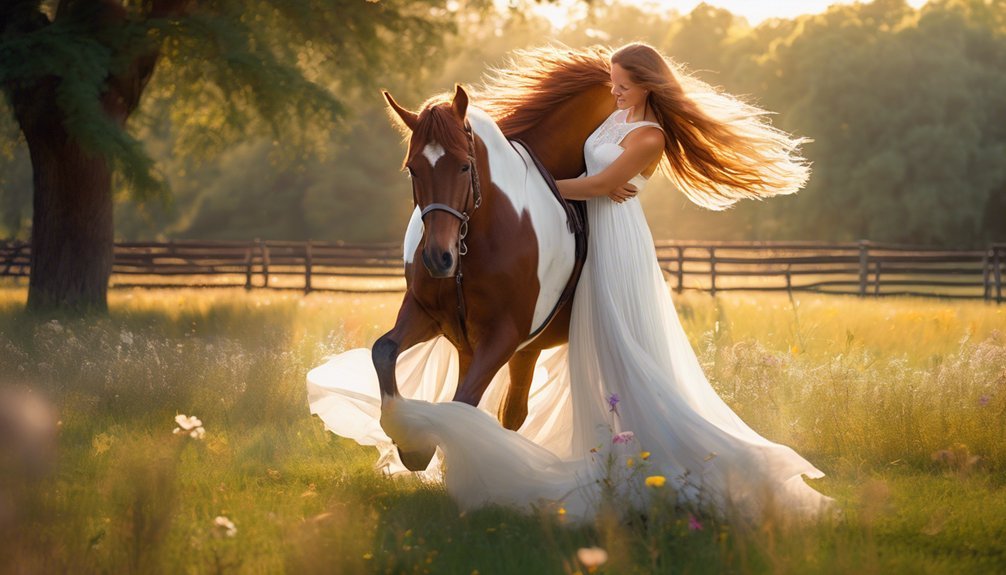
Nothing compares to the joy of shared experiences between you and your horse, as each ride or adventure strengthens your bond and creates lasting memories.
These moments become treasured equestrian memories that you'll cherish forever.
Here are some ways to enhance your shared adventures:
- Trail Rides: Explore new paths together, enjoying nature's beauty.
- Competitions: Celebrate each achievement, big or small, as a team.
- Grooming Sessions: Spend quiet time bonding, strengthening trust and connection.
- Training Challenges: Work together to overcome obstacles, fostering growth and understanding.
Every shared experience enriches your journey, reminding you that the heart of equestrian life lies in the connections you forge with your horse.
Embrace these moments; they're truly special!
Frequently Asked Questions
How Do I Choose the Right Horse for My Riding Style?
To choose the right horse for your riding style, consider the horse's temperament and how it aligns with your preferred riding discipline. A calm, responsive horse will enhance your enjoyment and connection during every ride.
What Equipment Is Essential for a Positive Horse-Rider Relationship?
To foster a positive bond, you need well-fitted saddles and suitable bridle types. These essentials ensure comfort and communication, allowing you and your horse to connect deeply, enhancing your shared experiences and mutual trust.
How Can I Tell if My Horse Is Happy?
Imagine your horse's ears flicking like a butterfly's wings; that's joy. Pay attention to body language and emotional signals—soft eyes, relaxed posture, and playful behavior all indicate your horse's happiness and contentment.
Are Certain Breeds Better for Beginners?
Certain breeds, like Quarter Horses and Appaloosas, are great for beginners due to their calm temperament traits. You'll find they're friendly and easy to handle, making your early riding experiences enjoyable and rewarding.
How Often Should I Ride to Maintain a Strong Bond?
To strengthen your bond, aim for consistent riding frequency, engage in bonding activities like grooming and groundwork, and cherish your time together. The more you connect, the deeper your relationship will grow and flourish.
Conclusion
So, next time you're out there trying to convince your horse that jumping over a log isn't a death sentence, remember: trust and communication are key! You might not be able to explain why that squirrel is a threat, but hey, at least you two can bond over the shared terror. Embrace the chaos, cherish those moments of triumph (or utter hilarity), and you'll find that this partnership, however ridiculous at times, is worth every hoofprint on your heart.




